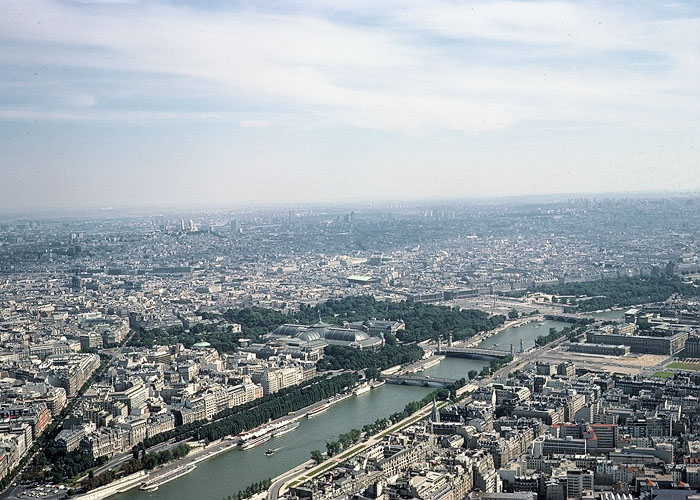
View of Seine River from Eiffel Tower looking north-northeast toward right bank. The city of Paris is divided into twenty arrondissements, or sections, whose increasing numbers spiral outward in a counterclockwise direction from the center around Ile de la Cité and the Louvre. The Right Bank is on the north side of the Seine River and the Left Bank or Latin Quarter is on the south side of the river. On the Right Bank one can see a glass-roofed building which is the “Grand Palais” and the Sacré Coeur cathedral is barely visible.
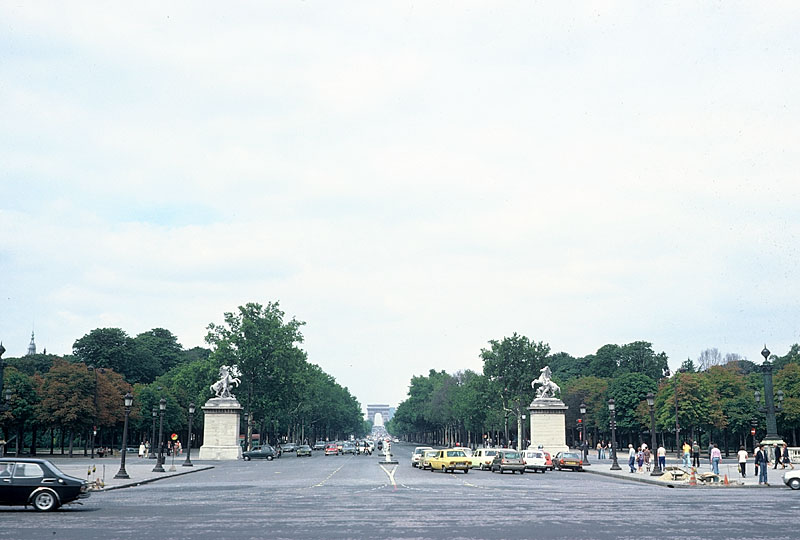
View of entrance to Champs-Élysées with Arc of Triumph on horizon. The Arc of Triumph or l’Arc de Triomphe was meant to commemorate Napoleon’s victories in the early 1800s and evokes imperial glory and the fate of the unknown soldier whose tomb lies beneath. The construction of the monument was undertaken in 1806 when Napoleon envisioned a decorous monolith which would welcome the troops home and then continued almost twenty years later under Louis XVIII and until completion in 1836 when it was consecrated. Jean-Françoise-Thérèse Chalgrin is responsible for most of the design of the Arc. The names of Napoleon’s generals and battles are engraved inside. The Tomb of the Unknown Soldier, a French soldier from World War I, has lain under the Arc since 1920 and also commemorates the Frenchman who died in World War I.
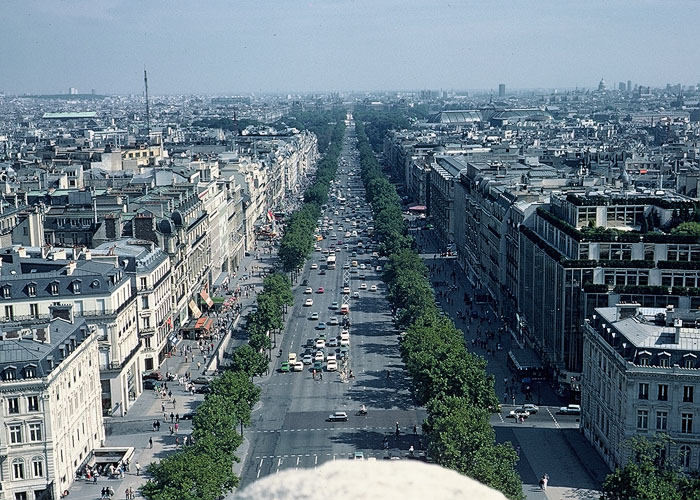
View of Champs Élysées from top of Arc of Triumph. The Champs Élysées is probably the most famous avenue in France. To Parisians it is the Voie Triumphal or Triumphal Way. The Avenue was born in 1616 when Marie de Medici ploughed the Cours-de-la-Reine through the fields and marshland west of the Louvre. It was an unkempt thoroughfare until the early nineteenth century, when the city built sidewalks and installed gas lighting. The height of the Champs was during the Second Empire (1852–1870) when elegant mansions sprang up along the avenue and splashy cafés catered to the beau monde. On Bastille Day, July 14th, military processions with musical bands draw huge crowds. Successive governments have made an effort to resurrect the avenue by widening the sidewalks, planting more trees, and building underground parking lots. The shops along the avenue range from the most celebrated clothing boutiques to the low-budget Monoprix. Overpriced cafés compete with fast-food outlets for the patronage of swarms of tourists. Glitzy nightclubs and multiplex cinemas draw large crowds well into the evening. Despite much commercialization the glamour of the Champs continues.
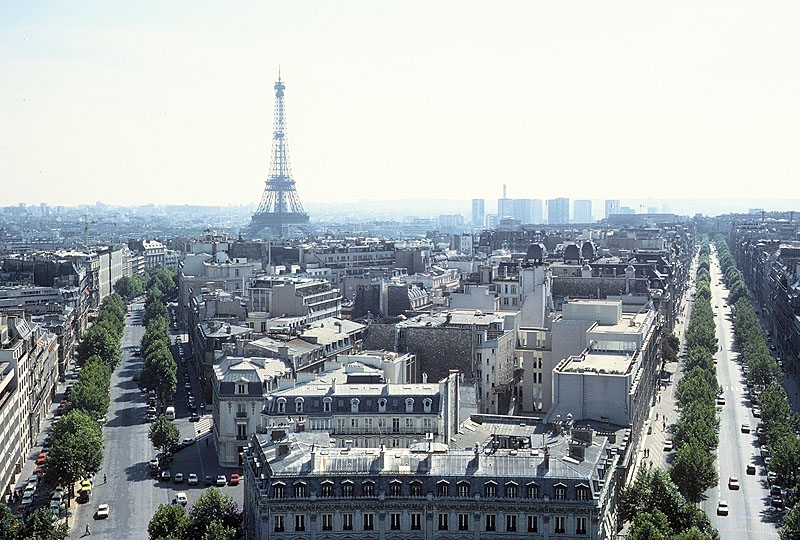
View of Eiffel Tower from top of Arc of Triumph looking down Avenues Kléber
and d’Iena. Inaugurated in 1889 as part of the World’s Fair,
the Eiffel Tower stands 1051 feet (320 meters) tall and is made of 7000 tons
of steel held together by 2.5 million rivets. Gustave Eiffel, who also engineered
the Statue of Liberty, designed the tower. With its antennae the Eiffel Tower
began serving as a radio tower in 1909. The distinctive bronze color is repainted
every seven years and is graduated from a lighter tone at the summit to a
darker one at the base to highlight the elegant line of perspective.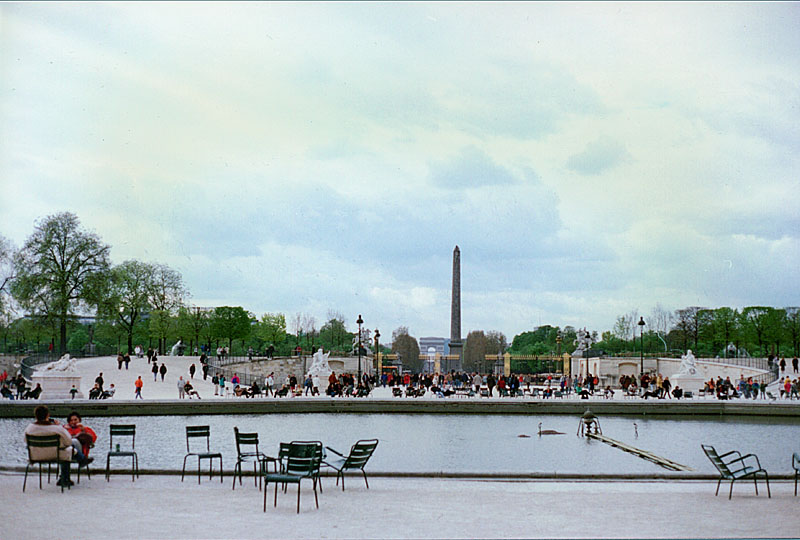
View of Place de la Concorde and Champs Élysées with Fountains. This is Paris’s largest and most infamous public square at the eastern terminus of the Champs-Élysées. In the center of the square is the monumental hieroglyphic-covered Obélisque de Luxor which was a gift from the viceroy of Egypt in the early 1800s and dates from the thirteenth century B.C.. The spot was originally occupied by a statue of Louis XV that was destroyed by an angry mob in the mid 1700s. Under Louis XV, the Place became and center of public grievance against the monarchy. Another statue of Louis XV was toppled in 1792 and the square then became Place de la Revolution and, the site of the guillotine that severed over thirteen hundred aristocratic heads including Danton Robespierre, Charlotte Corday, and King Louis XVI and Marie Antoinette. After the Reign of Terror, the square was optimistically named Place de lat Concorde and decorated further by King Louis Philippe in the 1800s.

View of the entrance to the Louvre with the pyramid. The architect I.M. Pei designed the pyramid; it is built of sheet glass supported on a framework of stainless-steel tubes. The elaborately decorated façades (Italian Renaissance style) surrounding and overlooking Cour Napoleon make a majestic backdrop to the sharply contrasting, rigidly geometric form of the glass pyramid at the centre of the courtyard.
For eight centuries, the Louvre was the seat of kings and emperors. It was originally a fort built by King Phillipe Auguste in the twelfth century. Numerous alterations by successive rulers made it into a vast royal palace. Louis XIV was the last King to make additions to the Louvre, yet they were interrupted when he built Versailles. The Louvre originally became a museum at the end of the Age of Enlightenment in 1793, a period which represented a thirst for knowledge. It is the longest building in Europe and today it continues to be one of the richest collections of art and antiquities in the world.
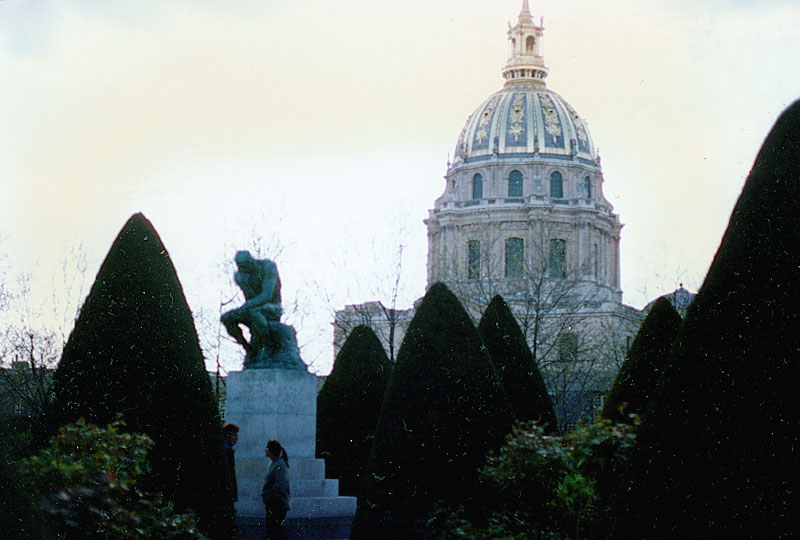
View of Hôtel des Invalides (Napoleon’s burial site) from grounds of Rodin Museum with silhouette of Thinker statue in foreground. This domed building served originally as a barracks for veterans of the French army beginning with Louis XIV. It now houses Napoleon’s tomb and the Army Museum.
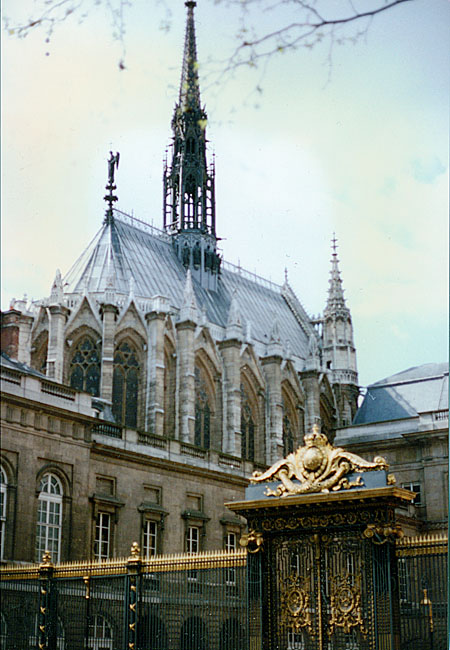
View of exterior of Sainte-Chapelle. The chapel was built on the orders of King Louis IX (St. Louis) to house the recently acquired holy relics of the Passion of the precincts of the royal palace. The masterpiece of High Gothic was completed only eighty years after Notre Dame cathedral of the Transitional Gothic style. The Sainte Chapelle exceeds in ambition even the achievements of Chartres and Amiens pushing Gothic to its limits. Architect Pierre de Montreuil built this by means of conventional buttresses supported by pinnacles and on two stories, the lower for the staff of the palace, and the upper for the monarch.
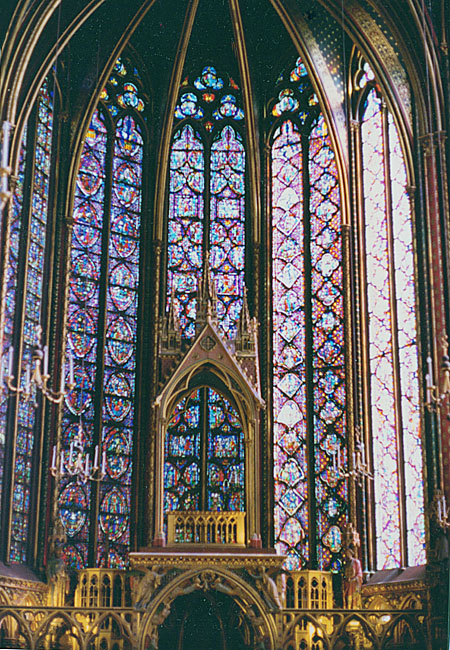
View of interior of sanctuary of Sainte-Chapelle with stained glass windows. The upper chapel resembles a shrine with the walls made almost entirely of stained glass covering a total area of over 6600 square feet and the windows rise to a height of nearly fifty feet. The stained glass is the oldest surviving in Paris and there are over 1100 scenes of which over 700 are original. The theme is Christ’s Passion, as foretold by the prophets and by John the Baptist, together with the episodes that led up to it. The glass of Sainte Chapelle has been much imitated, even in architecturally inappropriate situations.
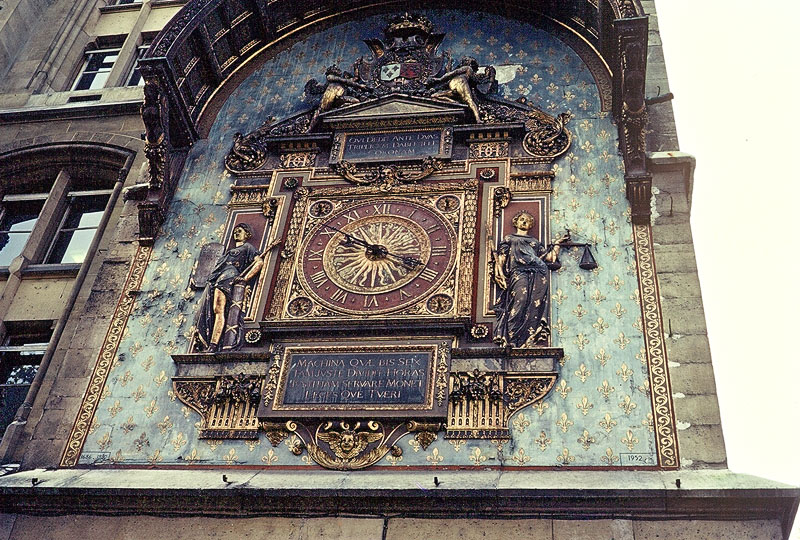
The oldest clock in France, building on Ile de la Cité, near Sainte Chapelle and the Conciergerie.
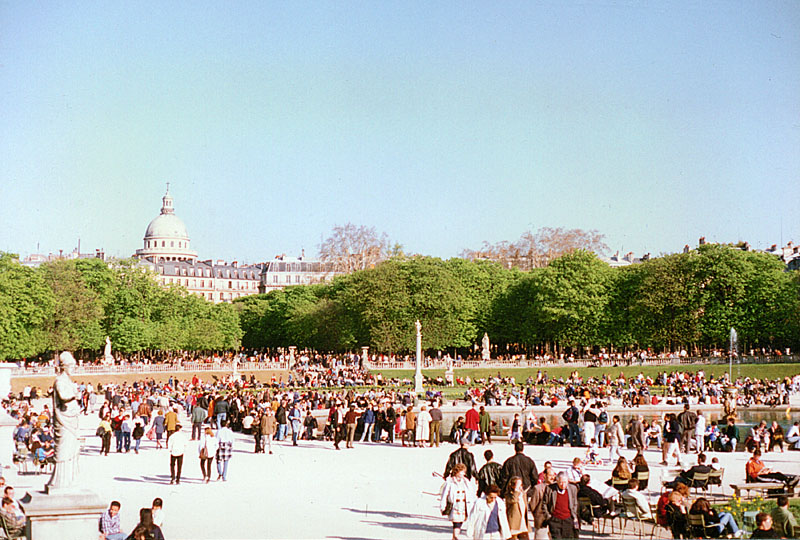
Park at Luxembourg Gardens, Left Bank, Parisians flock to these formal gardens to sunbathe, write, stroll, read, and gaze at the rose gardens and central pool. The gardens were liberated during the French Revolution and are now open to all. This is the most extensive green open space on the Left Bank, which is usually crowded with mothers, small children, students, and young people.
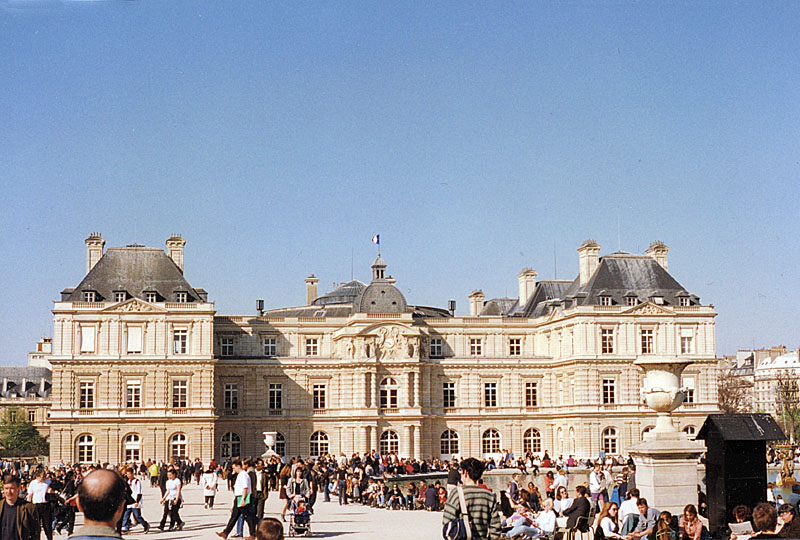
The Palace of Luxembourg within the Luxembourg Gardens is the home of the French Senate. It was built in 1615 at Marie de Medici’s request that tried to recreate the architecture of her native Florence for which she was homesick. Marie lived here only five years until a power play took place between her and her former ally, Cardinal Richelieu. The outcome was that Marie threw such a fit that her son, King Louis XIII, kicked her off the royal council and exiled her to Cologne. During the Revolution, the palace housed a mixed bag of people headed to the guillotine, including Tom Paine, who cheated death due to a clerical error. The palace has been home to the French Senate since 1879, yet was also inhabited by the Empress Josephine before Napoleon became Emperor and by the Nazis in World War II.
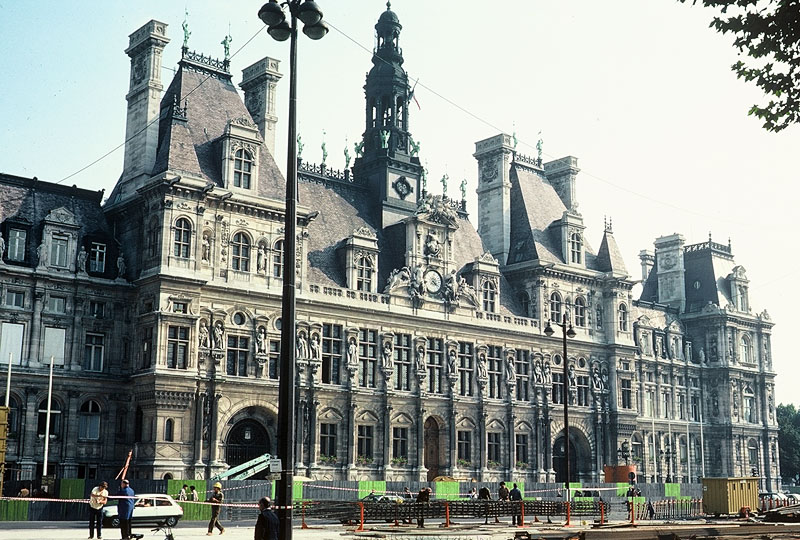
Hôtel de Ville. This is Paris’s grandiose city hall on the Right Bank which dominates the Place Hôtel-de-Ville, a large square punctuated with fountains and Belle Epoque lampposts. The present structure is the second reincarnation of an original edifice built during medieval times. The first building served as a meeting hall for merchants who controlled traffic on the Seine. Then King François I had it expanded in the early 1500s to reflect the style of Loire castles and be a more worthy City Hall to Parisians. The building was witness to municipal executions after Francis I and after the fall of the Bastille in July 1789, the rioters marched on the hall for arms. For much of the Revolution the town hall was controlled by the Commune and the National Convention. With another commune in 1871, the Paris Commune, there was a revolt against the government by the Federalists, or communards, who burned the Hôtel de Ville. The Third Republic built an identical structure on the ruins with only few major changes.
